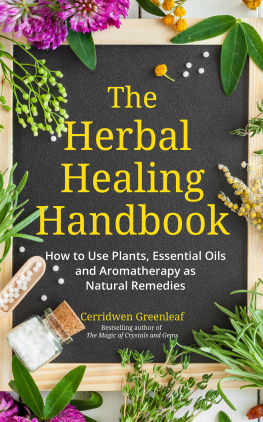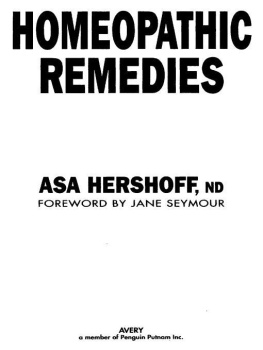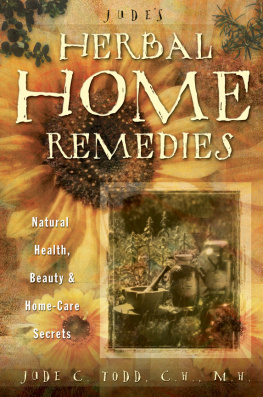Karen Sullivan - Natural Remedies: Aromatherapy, Herbalism, Home Remedies, Homeopathy, Nutrition
Here you can read online Karen Sullivan - Natural Remedies: Aromatherapy, Herbalism, Home Remedies, Homeopathy, Nutrition full text of the book (entire story) in english for free. Download pdf and epub, get meaning, cover and reviews about this ebook. year: 2011, publisher: Flame Tree Publishing, genre: Home and family. Description of the work, (preface) as well as reviews are available. Best literature library LitArk.com created for fans of good reading and offers a wide selection of genres:
Romance novel
Science fiction
Adventure
Detective
Science
History
Home and family
Prose
Art
Politics
Computer
Non-fiction
Religion
Business
Children
Humor
Choose a favorite category and find really read worthwhile books. Enjoy immersion in the world of imagination, feel the emotions of the characters or learn something new for yourself, make an fascinating discovery.

- Book:Natural Remedies: Aromatherapy, Herbalism, Home Remedies, Homeopathy, Nutrition
- Author:
- Publisher:Flame Tree Publishing
- Genre:
- Year:2011
- Rating:5 / 5
- Favourites:Add to favourites
- Your mark:
- 100
- 1
- 2
- 3
- 4
- 5
Natural Remedies: Aromatherapy, Herbalism, Home Remedies, Homeopathy, Nutrition: summary, description and annotation
We offer to read an annotation, description, summary or preface (depends on what the author of the book "Natural Remedies: Aromatherapy, Herbalism, Home Remedies, Homeopathy, Nutrition" wrote himself). If you haven't found the necessary information about the book — write in the comments, we will try to find it.
Offering new ways of treating a condition Natural Remedies is packed with information for you and your family and includes aromatherapy, herbal therapy, homeopathic treatments, nutrition, massage and counselling.
Natural Remedies: Aromatherapy, Herbalism, Home Remedies, Homeopathy, Nutrition — read online for free the complete book (whole text) full work
Below is the text of the book, divided by pages. System saving the place of the last page read, allows you to conveniently read the book "Natural Remedies: Aromatherapy, Herbalism, Home Remedies, Homeopathy, Nutrition" online for free, without having to search again every time where you left off. Put a bookmark, and you can go to the page where you finished reading at any time.
Font size:
Interval:
Bookmark:

Understanding Aromatherapy
The word aromatherapy literally means treatment using scents, and the therapy has evolved as a branch of herbal medicine. Unlike the herbs used in herbal medicine, essential oils are not taken internally but are inhaled or applied to the skin.
Aromatherapy Treatment
Aromatherapy is gentle enough to be used by people of all ages and states of health. It is nurturing for babies and children and offers comfort and care to the elderly. Pregnant women, and even seriously ill patients can benefit from professional treatment. The therapy has been shown to be particularly effective in preventing and treating stress and anxiety-related disorders, muscular and rheumatic pains, digestive problems, menstrual irregularities, menopausal complaints, insomnia and depression.
Be Aware
Aromatherapy is compatible with conventional medicine and most other forms of holistic treatment. However, if you are taking other medication, consult your doctor first. Some oils are not compatible with homeopathic treatment. Aromatherapy is safe to use at home for minor or short-term problems providing you follow certain guidelines:
- Do not: take essential oils internally unless advised by a registered aromatherapist.
- Do not: apply them undiluted to the skin unless it is stated that it is safe to do so.
- Do not: put essential oils in the eyes.
- Do not: keep essential oils where children can reach them.
Consult a qualified practitioner for advice and treatment if you:
- Are pregnant
- Have an allergy
- Have a chronic condition such as high blood pressure or epilepsy
- Are receiving medical or psychiatric treatment
- Are taking homeopathic remedies
- Are treating an infant
Essential Oils
Essential oils are extracted from the aromatic essences of certain plants, trees, fruit, flowers, herbs and spices. They are natural, volatile oils with identifiable chemical and medicinal properties. Over 150 essential oils have been extracted, each one with its own scent and unique healing properties. Oils are sourced from plants as commonplace as parsley and as exquisite as jasmine. For optimum benefits, essential oils must be extracted from natural raw ingredients and remain as pure as possible.
Essential oils can be used alone or blended together. Oils are blended to create a more sophisticated fragrance or to enhance or change the medicinal actions of the oils. When blended well, therapists can create a synergistic blend, where the oils work in harmony and to great effect.
How Essential Oils Work
Essential oils enter the body by inhalation and absorption through the pores of the skin. Once in the body, they work in three ways: pharmacologically, physiologically and psychologically. The chemical constituents of the oils are carried in the bloodstream to all areas of the body, where they react with the bodys chemistry in a way that is similar to drugs. Certain oils also have an affinity with particular areas of the body, and their properties have balancing, sedating or stimulating effects on body systems. Once inhaled, aromatic signals are sent to the limbic system of the brain, where they exert a direct effect on the mind and emotions.
Properties of Oils
The oils and their actions are extremely complex. All the oils are antiseptic, but each one also has individual properties; for example, they may be analgesic, fungicidal, diuretic or expectorant. The collective components of each oil also work together to give it a dominant characteristic. It can be relaxing, refreshing or stimulating. Essential oils also have notable physiological effects. Certain oils have an affinity with particular areas of the body. For example, rose has an affinity with the female reproductive system, while spice oils tend to benefit the digestive system. The oil may also sedate an overactive system, or stimulate a different part of the body that is sluggish. Some oils such as lavender are known as adaptogens, meaning they do whatever the body requires of them at the time. The psychological response is triggered by the effect of the aromatic molecules on the brain.
Treating Yourself
There are many ways to use essential oils at home. Massage and bathing tend to be the most popular, and techniques that involve applying oils to the body are usually more effective than inhalation. However, there are several other techniques that are particularly beneficial for certain conditions. These include steam inhalations, creams, lotions and shampoos, gargles and mouthwashes, neat applications (only appropriate for some oils), douches and compresses.
Carrier Oils
When essential oils are used for massage, they must be mixed into a base or carrier, as they are too concentrated and powerful to be used on the skin in an undiluted form. Carrier oils also provide the lubrication needed for the massage itself.A carrier oil can be any unperfumed vegetable oil, such as soya, safflower or sunflower oils, although the oils most often used in aromatherapy are sweet almond oil and grapeseed oil. Some carrier oils have therapeutic qualities of their own for example, peach kernel, avocado and apricot kernel are rich and nourishing, and high in vitamin E. Olive oil has many healing properties, although its strong odour sometimes masks the scent of the oil itself. A good ratio of oils is three drops of essential oil for every 5 ml of carrier oil.
Flowers
Flowers are used in essential oils for treating a wide range of ailments, from anxiety to throat infections. They were used as perfumes in ancient times to prevent diseases, then believed to be spread through bad odours.Their scents are among the most soothing of all oils, and flowers such as lavender have long been used to combat stress and aid sleep.
Rose (Rosa centifolia, R. damascena)
The rose has many therapeutic properties but its oil is very expensive to produce. The oil is distilled from the blossoms of the rose, usually from two types of roses, although there are many variations. The oils vary slightly in colour and fragrance, but have similar properties and uses. Rose oil can be used in tiny quantities and still be extremely effective.
Female Ailments
A renowned aphrodisiac, sedative and a tonic with antidepressant properties, rose has an affinity with the female reproductive system, helping to regulate the menstrual cycle and alleviate premenstrual syndrome (PMS) or postnatal depression. Broken veins, ageing or wrinkled skin also benefit from treatment with the essential oil. Rose should not be used during the first three months of pregnancy and not at all if there is a history of miscarriage.
Other Uses
Rose is useful in treating headaches, earache, conjunctivitis, coughs and hay fever. In some cases it can help to encourage wound healing. Rose oil is a powerful antiseptic against viruses and bacteria; it acts as a tonic for the heart, circulation, liver, stomach and uterus, and helps to detoxify the blood and organs.
Jasmine (Jasminum officinale)
Jasmine is known as the king of essential oils, largely because it takes so many flowers to produce a small quantity of this expensive oil, and because just a little oil offers profound therapeutic benefits. Very rarely jasmine may cause an allergic reaction.
Help for Men and Women
Jasmine has a reputation as an aphrodisiac, reducing impotence in men and frigidity in women. It is also a uterine tonic which can help with period pain and disorders of the uterus; its pain-relieving properties and ability to strengthen contractions make it one of the best oils to use during childbirth; it is also believed to strengthen male sex organs and has been used for prostate problems. Its relaxing and antidepressant effect helps with postnatal depression.
Font size:
Interval:
Bookmark:
Similar books «Natural Remedies: Aromatherapy, Herbalism, Home Remedies, Homeopathy, Nutrition»
Look at similar books to Natural Remedies: Aromatherapy, Herbalism, Home Remedies, Homeopathy, Nutrition. We have selected literature similar in name and meaning in the hope of providing readers with more options to find new, interesting, not yet read works.
Discussion, reviews of the book Natural Remedies: Aromatherapy, Herbalism, Home Remedies, Homeopathy, Nutrition and just readers' own opinions. Leave your comments, write what you think about the work, its meaning or the main characters. Specify what exactly you liked and what you didn't like, and why you think so.





